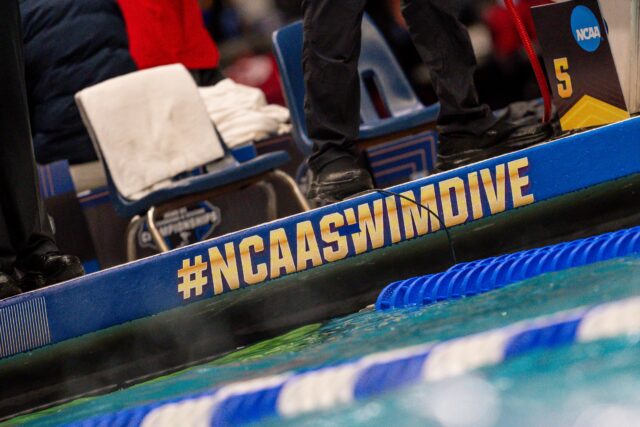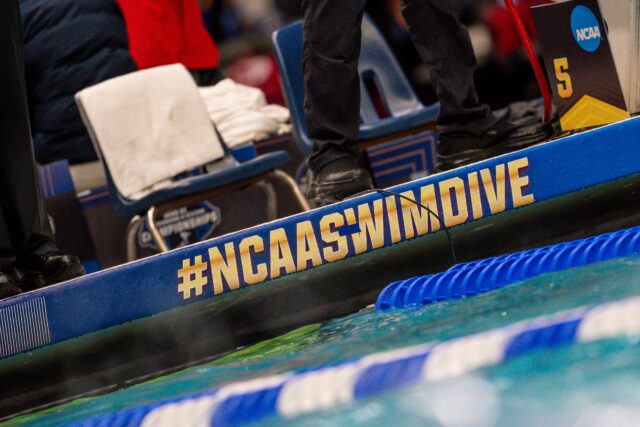By Madeline Folsom on SwimSwam

Terin Frodyma contributed to this report.
The NCAA swimming and diving season started weeks ago with many teams already swimming their first meets, and the NCAA announced today that they approved proposed changes to the Division I NCAA Championship format for the upcoming 2026 Championships.
In July, the College Swimming and Diving Coaches Association of America (CSCAA) submitted a two-part proposal to the NCAA Sport Oversight Commission that consisted of numerous changes to the current NCAA Championship model. These changes included removing ‘B’ finals, rescheduling the competition to optimize broadcasting, shuffling the order of events, and introducing a new qualification model.
The proposal was originally tabled in August due to organizational changes in the NCAA, and the 2025-26 season started a few weeks ago.
Though the CSCAA told SwimSwam in August that there were no anticipated changes for the 2026 Championships, the newly formed NCAA Swimming and Diving Oversight Committee approved the proposal today to take effect for this season.
The approved changes are intended to modernize and expand the college swimming and diving landscape, and they are exactly as we reported back in July.
One of the changes we will see is an updated order of events intended to optimize viewing and put “high-profile” events on the last several days. At this time, no events are being added to the meet. The ‘B’ option for the standard order of events was the officially approved order, with potential for slight changes in the coming days.
Order of Events (Finals)
| Day Of Competition | Old Format | New Format |
| Day 1 | 200 Medley Relay |
1,650 Freestyle — Top 8 seeds
|
| 800 Freestyle Relay |
200 Medley Relay
|
|
|
800 Freestyle Relay
|
||
| Day 2 | 500 Freestyle | 100 Butterfly |
| 200 Individual Medley |
400 Individual Medley
|
|
| 50 Freestyle |
One-Meter Diving (rds 1-3)
|
|
| One-Meter Diving | 200 Freestyle | |
| 200 Freestyle Relay | 100 Backstroke | |
|
One-Meter Diving (rds 4-6)
|
||
|
200 Freestyle Relay
|
||
| Day 3 | 100 Butterfly | 500 Freestyle |
| 400 Individual Medley | 50 Freestyle | |
| 200 Freestyle |
Three-Meter Diving (rds 1-3)
|
|
| 100 Breaststroke | 200 Backstroke | |
| 100 Backstroke |
200 Breaststroke
|
|
| Three-Meter Diving |
Three-Meter Diving (rds 4-6)
|
|
| 400 Medley Relay |
400 Medley Relay
|
|
| Day 4 | 1650 Freestyle |
200 Individual Medley
|
| 200 Backstroke | 100 Freestyle | |
| 100 Freestyle |
Platform Diving (rds 1-3)
|
|
| 200 Breaststroke | 200 Butterfly | |
| 200 Butterfly |
100 Breaststroke
|
|
| Platform Diving |
Platform Diving (rds 4-6)
|
|
| 400 Freestyle Relay |
400 Freestyle Relay
|
Final Scoring for 9th–16th Places to Come from Prelims
One of the most immediate and noticeable changes comes in the way consolation places are scored. In the morning prelims, swimmers and divers in 9th–16th positions will no longer compete in a nighttime B-final for consolation placement; their finishes will instead be determined by morning preliminary times alone.
Relays will compete as a Timed Finals event with the top eight seeds swimming in the finals session and all other teams competing in the morning.
The move aims to give more importance to the morning swims and provide the primetime broadcast a focus on championship races for national titles. The top 8 from prelims will still advance to finals.
Broadcast-Driven Rescheduling: Diving Split, Awards Moved, Events re-ordered
Diving finals will be split into two segments—three rounds early in the session, and three more later—offering shorter, more digestible coverage windows and giving swimmers rest between events. Award ceremonies will also be moved out of the session flow to help broadcasts run cleaner and with fewer interruptions.
The meet program has also been modified, with more high-profile events scheduled for the last several days. According to the report, the changes “are strategically designed to elevate the championship’s linear broadcast potential without negatively impacting student-athletes” and that “marquee events will now anchor the final days of competition.”
While ESPN does not share audience numbers for its streaming events, in-person attendance at the meet historically has grown throughout the meet, peaking on Friday and Saturday evenings.
New Qualification Model: Win-and-In With a Standard
The new format transforms the qualification procedure, instituting a single NCAA Championship standard. Under the new rules, any swimmer who wins their conference title and achieves a national qualifying time in the event will automatically qualify for the NCAA Championships. The descending order list procedure will continue to be used for all other entries, though the idea of an “A” and a “B” standard has been eliminated.
With the goal to preserve meet size and expand institutional access, the qualifying times were determined by averaging the 72nd-best time over the previous three years unless the current standard is faster than the three-year average. You can see all of the standards here.
Diving qualification remains unchanged and continues to rely on Zone meets for qualification standards.
Read the full story on SwimSwam: NCAA Approves Changes to 2026 Division I Championships Weeks After Season Starts


